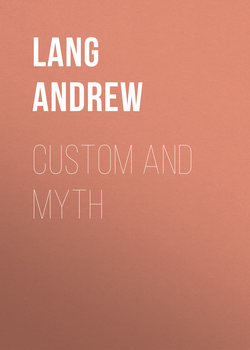Custom and Myth

Реклама. ООО «ЛитРес», ИНН: 7719571260.
Оглавление
Lang Andrew. Custom and Myth
INTRODUCTION
THE METHOD OF FOLKLORE
THE BULL-ROARER. A Study of the Mysteries
THE MYTH OF CRONUS
CUPID, PSYCHE, AND THE ‘SUN-FROG.’
A FAR-TRAVELLED TALE
APOLLO AND THE MOUSE
STAR MYTHS
MOLY AND MANDRAGORA
‘KALEVALA’; OR, THE FINNISH NATIONAL EPIC
THE DIVINING ROD
HOTTENTOT MYTHOLOGY
FETICHISM AND THE INFINITE
THE EARLY HISTORY OF THE FAMILY
THE ART OF SAVAGES. 223
Отрывок из книги
After the heavy rain of a thunderstorm has washed the soil, it sometimes happens that a child, or a rustic, finds a wedge-shaped piece of metal or a few triangular flints in a field or near a road. There was no such piece of metal, there were no such flints, lying there yesterday, and the finder is puzzled about the origin of the objects on which he has lighted. He carries them home, and the village wisdom determines that the wedge-shaped piece of metal is a ‘thunderbolt,’ or that the bits of flint are ‘elf-shots,’ the heads of fairy arrows. Such things are still treasured in remote nooks of England, and the ‘thunderbolt’ is applied to cure certain maladies by its touch.
As for the fairy arrows, we know that even in ancient Etruria they were looked on as magical, for we sometimes see their points set, as amulets, in the gold of Etruscan necklaces. In Perugia the arrowheads are still sold as charms. All educated people, of course, have long been aware that the metal wedge is a celt, or ancient bronze axe-head, and that it was not fairies, but the forgotten peoples of this island who used the arrows with the tips of flint. Thunder is only so far connected with them that the heavy rains loosen the surface soil, and lay bare its long hidden secrets.
.....
Now the peculiarity of the method of folklore is that it will venture to compare (with due caution and due examination of evidence) the myths of the most widely severed races. Holding that myth is a product of the early human fancy, working on the most rudimentary knowledge of the outer world, the student of folklore thinks that differences of race do not much affect the early mythopœic faculty. He will not be surprised if Greeks and Australian blacks are in the same tale.
In each case, he holds, all the circumstances of the case must be examined and considered. For instance, when the Australians tell a myth about the Pleiades very like the Greek myth of the Pleiades, we must ask a number of questions. Is the Australian version authentic? Can the people who told it have heard it from a European? If these questions are answered so as to make it apparent that the Australian Pleiad myth is of genuine native origin, we need not fly to the conclusion that the Australians are a lost and forlorn branch of the Aryan race. Two other hypotheses present themselves. First, the human species is of unknown antiquity. In the moderate allowance of 250,000 years, there is time for stories to have wandered all round the world, as the Aggry beads of Ashanti have probably crossed the continent from Egypt, as the Asiatic jade (if Asiatic it be) has arrived in Swiss lake-dwellings, as an African trade-cowry is said to have been found in a Cornish barrow, as an Indian Ocean shell has been discovered in a prehistoric bone-cave in Poland. This slow filtration of tales is not absolutely out of the question. Two causes would especially help to transmit myths. The first is slavery and slave-stealing, the second is the habit of capturing brides from alien stocks, and the law which forbids marriage with a woman of a man’s own family. Slaves and captured brides would bring their native legends among alien peoples.
.....